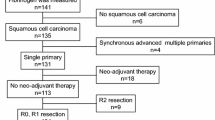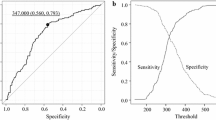Abstract
Purpose
Although hyperfibrinogenemia has been reported in patients with colorectal cancer, neither its clinical implications nor the effect of chemoradiotherapy (CRT) on the fibrinogen levels have been fully investigated. We investigated the clinical significance of pre- and post-CRT fibrinogen levels in patients with rectal cancer.
Methods
The medical records of 82 patients with rectal cancer, who had received CRT followed by surgical resection, were retrospectively reviewed. The correlation between the clinicopathological variables and the pre- and post-CRT plasma fibrinogen levels, and that between the changes of fibrinogen, C-reactive protein (CRP), or carcinoembryonic antigen (CEA) levels after CRT and the pathological tumor regression grading was analyzed. Furthermore, the impact of post-CRT fibrinogen levels on the prognosis of these patients was assessed.
Results
Plasma fibrinogen markedly decreased after CRT. The post-CRT fibrinogen level significantly correlated with lymphatic invasion, venous invasion, tumor size, depth of invasion, and the pathological tumor regression grading. The CRT-induced pathological tumor regression grading well correlated with the decrease of fibrinogen level, but not with that of CRP or CEA. Furthermore, patients with high post-CRT fibrinogen had significantly shorter disease-free survival.
Conclusions
Reduction of plasma fibrinogen induced by CRT should be a promising biomarker for evaluating the efficacy of CRT in rectal cancer patients.



Similar content being viewed by others
References
Tomimaru Y, Yano M, Takachi K, Kishi K, Miyashiro I, Ohue M et al (2006) Plasma D-dimer levels show correlation with number of lymph node metastases in patients with esophageal cancer. J Am Coll Surg 202(1):139–145
Altiay G, Ciftci A, Demir M, Kocak Z, Sut N, Tabakoglu E et al (2007) High plasma D-dimer level is associated with decreased survival in patients with lung cancer. Clin Oncol R Coll Radiol 19(7):494–498
Kilic M, Yoldas O, Keskek M, Ertan T, Tez M, Gocmen E et al (2008) Prognostic value of plasma D-dimer levels in patients with colorectal cancer. Colorectal Dis 10(3):238–241
Levitan N, Dowlati A, Remick SC, Tahsildar HI, Sivinski LD, Beyth R et al (1999) Rates of initial and recurrent thromboembolic disease among patients with malignancy versus those without malignancy. Risk analysis using Medicare claims data. Med Baltim 78(5):285–291
Yamashita H, Kitayama J, Nagawa H (2005) Hyperfibrinogenemia is a useful predictor for lymphatic metastasis in human gastric cancer. Jpn J Clin Oncol 35(10):595–600
Yamashita H, Kitayama J, Kanno N, Yatomi Y, Nagawa H (2006) Hyperfibrinogenemia is associated with lymphatic as well as hematogenous metastasis and worse clinical outcome in T2 gastric cancer. BMC Cancer 6:147
Yamashita H, Kitayama J, Taguri M, Nagawa H (2009) Effect of preoperative hyperfibrinogenemia on recurrence of colorectal cancer without a systemic inflammatory response. World J Surg 33(6):1298–1305
ten Cate H, Falanga A (2008) Overview of the postulated mechanisms linking cancer and thrombosis. Pathophysiol Haemost Thromb 36(3–4):122–130
Sauer R, Becker H, Hohenberger W, Rodel C, Wittekind C, Fietkau R et al (2004) Preoperative versus postoperative chemoradiotherapy for rectal cancer. N Engl J Med 351(17):1731–1740
Watanabe T, Nagawa H (2004) Sphincter preservation in locally advanced rectal cancer due to the addition of continuous infusion 5-FU to preoperative radiation therapy or advances in surgical techniques? Int J Radiat Oncol Biol Phys 59(2):618, author reply 618
Bosset JF, Collette L, Calais G, Mineur L, Maingon P, Radosevic-Jelic L et al (2006) Chemotherapy with preoperative radiotherapy in rectal cancer. N Engl J Med 355(11):1114–1123
Fu CG, Tominaga O, Nagawa H, Nita ME, Masaki T, Ishimaru G et al (1998) Role of p53 and p21/WAF1 detection in patient selection for preoperative radiotherapy in rectal cancer patients. Dis Colon Rectum 41(1):68–74
Marquardt F, Rodel F, Capalbo G, Weiss C, Rodel C (2009) Molecular targeted treatment and radiation therapy for rectal cancer. Strahlenther Onkol 185(6):371–378
Kuremsky JG, Tepper JE, McLeod HL (2009) Biomarkers for response to neoadjuvant chemoradiation for rectal cancer. Int J Radiat Oncol Biol Phys 74(3):673–688
Kikuchi M, Mikami T, Sato T, Tokuyama W, Araki K, Watanabe M et al (2009) High Ki67, Bax, and thymidylate synthase expression well correlates with response to chemoradiation therapy in locally advanced rectal cancers: proposal of a logistic model for prediction. Br J Cancer 101(1):116–123
Komuro Y, Watanabe T, Hosoi Y, Matsumoto Y, Nakagawa K, Tsuno N et al (2002) The expression pattern of Ku correlates with tumor radiosensitivity and disease free survival in patients with rectal carcinoma. Cancer 95(6):1199–1205
Komuro Y, Watanabe T, Tsurita G, Muto T, Nagawa H (2005) Evaluating the combination of molecular prognostic factors in tumor radiosensitivity in rectal cancer. Hepatogastroenterology 52(63):666–671
Komuro Y, Watanabe T, Tsurita G, Muto T, Nagawa H (2005) Expression pattern of telomerase reverse transcriptase in rectal carcinoma predicts tumor radiosensitivity, local recurrence and disease-free survival. Hepatogastroenterology 52(64):985–989
Dworak O, Keilholz L, Hoffmann A (1997) Pathological features of rectal cancer after preoperative radiochemotherapy. Int J Colorectal Dis 12(1):19–23
Marchena J, Acosta MA, Garcia-Anguiano F, Simpson H, Cruz F (2003) Use of the preoperative levels of CEA in patients with colorectal cancer. Hepatogastroenterology 50(52):1017–1020
Redman CM, Xia H (2001) Fibrinogen biosynthesis. Assembly, intracellular degradation, and association with lipid synthesis and secretion. Ann NY Acad Sci 936:480–495
Martini WZ (2009) Fibrinogen metabolic responses to trauma. Scand J Trauma Resusc Emerg Med 17(1):2
Collen D, Tytgat GN, Claeys H, Piessens R (1972) Metabolism and distribution of fibrinogen. I. Fibrinogen turnover in physiological conditions in humans. Br J Haematol 22(6):681–700
Zhang Z, Fuller GM (2000) Interleukin 1beta inhibits interleukin 6-mediated rat gamma fibrinogen gene expression. Blood 96(10):3466–3472
Albrecht U, Yang X, Asselta R, Keitel V, Tenchini ML, Ludwig S et al (2007) Activation of NF-kappaB by IL-1beta blocks IL-6-induced sustained STAT3 activation and STAT3-dependent gene expression of the human gamma-fibrinogen gene. Cell Signal 19(9):1866–1878
Grieninger G, Plant PW, Liang TJ, Kalb RG, Amrani D, Mosesson MW et al (1983) Hormonal regulation of fibrinogen synthesis in cultured hepatocytes. Ann NY Acad Sci 408:469–489
Seebacher V, Polterauer S, Grimm C, Husslein H, Leipold H, Hefler-Frischmuth K et al (2010) The prognostic value of plasma fibrinogen levels in patients with endometrial cancer: a multi-centre trial. Br J Cancer 102(6):952–956
Rybarczyk BJ, Simpson-Haidaris PJ (2000) Fibrinogen assembly, secretion, and deposition into extracellular matrix by MCF-7 human breast carcinoma cells. Cancer Res 60(7):2033–2039
Yamaguchi T, Yamamoto Y, Yokota S, Nakagawa M, Ito M, Ogura T (1998) Involvement of interleukin-6 in the elevation of plasma fibrinogen levels in lung cancer patients. Jpn J Clin Oncol 28(12):740–744
Panes J, Granger DN (1996) Neutrophils generate oxygen free radicals in rat mesenteric microcirculation after abdominal irradiation. Gastroenterology 111(4):981–989
Debucquoy A, Goethals L, Geboes K, Roels S, McBride WH, Haustermans K (2006) Molecular responses of rectal cancer to preoperative chemoradiation. Radiother Oncol 80(2):172–177
Wichmann MW, Meyer G, Adam M, Hochtlen-Vollmar W, Angele MK, Schalhorn A et al (2003) Detrimental immunologic effects of preoperative chemoradiotherapy in advanced rectal cancer. Dis Colon Rectum 46(7):875–887
Simpson-Haidaris PJ, Rybarczyk B (2001) Tumors and fibrinogen. The role of fibrinogen as an extracellular matrix protein. Ann NY Acad Sci 936:406–425
Palumbo JS, Potter JM, Kaplan LS, Talmage K, Jackson DG, Degen JL (2002) Spontaneous hematogenous and lymphatic metastasis, but not primary tumor growth or angiogenesis, is diminished in fibrinogen-deficient mice. Cancer Res 62(23):6966–6972
Zheng S, Shen J, Jiao Y, Liu Y, Zhang C, Wei M et al (2009) Platelets and fibrinogen facilitate each other in protecting tumor cells from natural killer cytotoxicity. Cancer Sci 100(5):859–865
Brown NJ, Staton CA, Rodgers GR, Corke KP, Underwood JC, Lewis CE (2002) Fibrinogen E fragment selectively disrupts the vasculature and inhibits the growth of tumours in a syngeneic murine model. Br J Cancer 86(11):1813–1816
Akakura N, Hoogland C, Takada YK, Saegusa J, Ye X, Liu FT et al (2006) The COOH-terminal globular domain of fibrinogen gamma chain suppresses angiogenesis and tumor growth. Cancer Res 66(19):9691–9697
Author information
Authors and Affiliations
Corresponding author
Rights and permissions
About this article
Cite this article
Kawai, K., Kitayama, J., Tsuno, N.H. et al. Hyperfibrinogenemia after preoperative chemoradiotherapy predicts poor response and poor prognosis in rectal cancer. Int J Colorectal Dis 26, 45–51 (2011). https://doi.org/10.1007/s00384-010-1054-y
Accepted:
Published:
Issue Date:
DOI: https://doi.org/10.1007/s00384-010-1054-y




